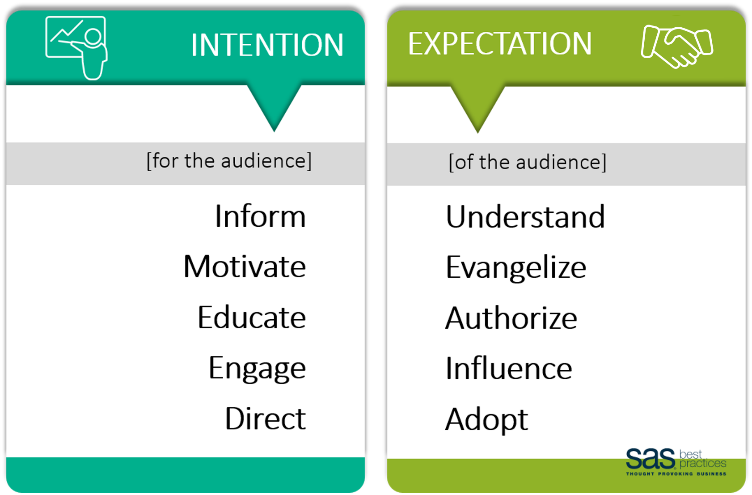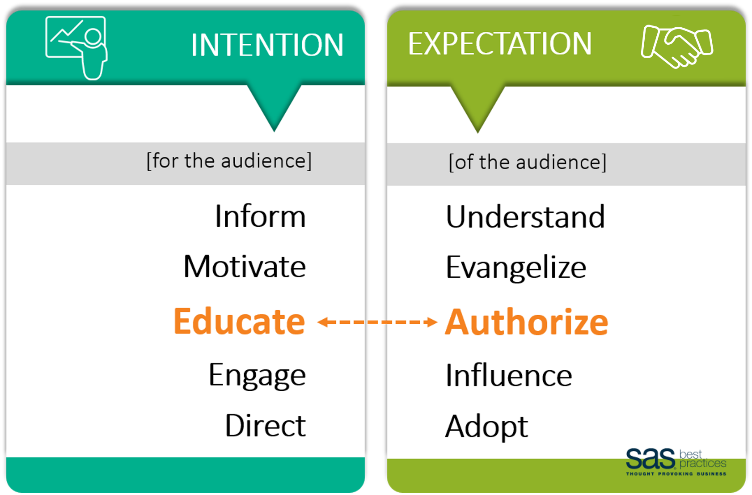Click to learn more about author Bree Baich.
“I could understand every word the professor was saying, but I couldn’t understand what he was talking about – I couldn’t link between the words. The way we communicate data is very similar because very often what we do is throw data points at people, we throw charts at people, but people don’t really understand the context behind it.” – Daniel Waisberg, Analytics Advocate at Google – Telling Data Stories, Strata + Hadoop World
A useful communication tool in the world of data is storytelling. Presenting complex theories to a non-technical audience is a huge struggle for many data professionals. Knowing how and when to use story can be just as challenging. The pivotal factor is your intent [for] and subsequent expectation [of] the audience.
Image Credit: SAS
For example, let’s say you’ve been working on a proof of concept (POC) and it’s time to communicate outcomes to the leadership team. Your intent is to educate the C-suite on how well the POC performed. Your expectation is an approval to take the POC enterprise-wide.
Image Credit: SAS
The great news could be communicated through email. However, it’s important to remember we make decisions both intellectually (IQ) and emotionally (EQ). If the information is difficult to interpret the C-suite may require additional explanation. Higher business priorities could delay their decision. The best approach is to get yourself in front of them.
I know what you’re thinking. “Great, another meeting no one has time for.” The beauty of this type of communication tool is that a well-planned narrative adds structure and purpose to a meeting. Stories navigate an audience from reality to recommendation in a quick, useful fashion.
When considering intention, storytelling may not always be the answer. If the goal is to communicate a company directive, a memo could get the job done. But, if you are tasked with delivering a directive that is hard to swallow, a story might help with adoption. Painting a picture of what the future could be makes it easier to get people onboard. Remember, it depends on what you intend to deliver and what you expect of the audience to determine if storytelling is the right tool.
Here are four key areas of business where story is the best choice.
Removing Complexity
Stories have the power to help an audience overcome the barriers of complexity.
In a recent episode of CBS’ Bull, Keep Your Friends Close, a key witness begins to explain how hackers access secure data – using terms like wireless access protocol, binary coding sequence and socket layers. As the jurors begin to disengage, the defense attorney asks him, “Can you explain that in a way that those of us who don’t use a computer for anything other than email might understand?” The witness then compares the task of shopping for socks online with the act of accessing complex, multi-layer security protocols of the FAA’s servers. The shift to story instantly removed barriers the jurors built while trying to understand the complexity of server hacking.
Stories place an audience in the driver’s seat. They navigate an audience through the twists and turns of complicated ideas, like socket layers, by clearing the road of confusing debris.
Raising Awareness
Stories shine a light on what may seem like, just another BIG number.
30 percent of students worldwide are bullied each year. Seems like a lot, but what does that mean? If you’ve been bullied, you get it. It’s personal. If not, 30 percent may seem like a statistic meant to shock and awe. Stories make data relevant. Burger King tackled the tough subject of school-aged bullying in an ad campaign. The commercial takes the audience through an eye-opening look at bullying with a light-hearted twist – giving viewers a firsthand perspective. When data becomes personal, an audience can see the consequence of remaining a bystander.
Stories add meaning and raise awareness to critical issues affecting our lives and organizations.
Enlisting Engagement
Stories jumpstart motivation when participation is imperative.
Fundraising is a stellar example. It’s not an easy task, but non-profits are versed at inspiring people to open their wallets and move off the sofa. Those who succeed understand their donor pool and the inescapable need to get them to feel something. “Through storytelling, nonprofits can harness the power of emotion to make a connection with donors,” says Sara Choe, customer advocate at CauseVox. Motivating an audience to act doesn’t take a team of experts to craft the right narrative. One of the most profitable GoFundMe efforts was accomplished by a seven-year-old child: Cookies for Mila. In just five months this little girl’s story about friendship has helped her surpass a $40,000 goal, and to date, she’s raised over $56,000.
That’s the power of story. It taps into our emotional intelligence (EQ) when it’s an audience-focused narrative.
Driving Change
Stories communicate the importance of a message when change is necessary.
One of the hardest jobs in business is leading change. Change for many is a scary, uncomfortable feat. For some, communicating upward is even harder. Imagine a Data Scientist within a mid-market company who’s seeing trends for products offered that have significant potential revenue decline. The data supports a possible shift in either marketing efforts or product line to remain profitable. No one asked for the information; it was the proactive nature of the Data Scientist that revealed trends. What now? To many the effort to communicate unsolicited change is insurmountable. To capture the attention this challenge requires, simply sharing the data won’t be enough. It must begin with a story. In this case, a story about how the customer experience could be improved with a few modifications is a good place to start.
Stories share the solution to a problem and include data points to support the narrative’s recommendation.
For more on how to communicate through story, download my latest ebook: The Mechanics of Storytelling. Some Assembly Required.


